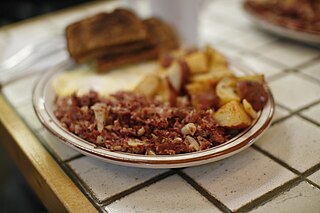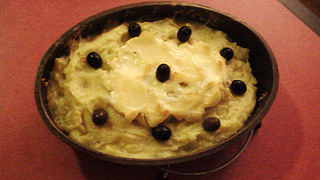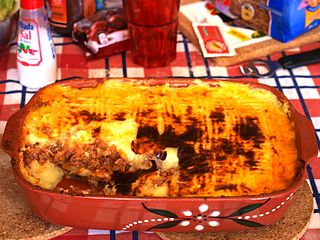
Lutefisk is dried whitefish. It is made from aged stockfish, or dried and salted cod, cured in lye. It is gelatinous in texture after being rehydrated for days prior to eating.

Hash is a culinary dish consisting of chopped meat, potatoes, and fried onions. The name is derived from French: hacher, meaning "to chop". It originated as a way to use up leftovers. In the U.S. by the 1860s, a cheap restaurant was called a "hash house" or "hashery."
Jamaican cuisine includes a mixture of cooking techniques, flavours and spices influenced by Amerindian, African, Irish, English, French, Portuguese, Spanish, Indian, Chinese and Middle Eastern people who have inhabited the island. It is also influenced by the crops introduced into the island from tropical Southeast Asia, many of which are now grown locally. A wide variety of seafood, tropical fruits and meats are available.

The oldest known book on Portuguese cuisine, entitled Livro de Cozinha da Infanta D. Maria de Portugal, from the 16th century, describes many popular dishes of meat, fish, poultry and others.

Bacalhau is the Portuguese word for cod and—in a culinary context—dried and salted cod. Fresh (unsalted) cod is referred to as bacalhau fresco.

Fresh fish rapidly deteriorates unless some way can be found to preserve it. Drying is a method of food preservation that works by removing water from the food, which inhibits the growth of microorganisms. Open air drying using sun and wind has been practiced since ancient times to preserve food. Water is usually removed by evaporation but, in the case of freeze-drying, food is first frozen and then the water is removed by sublimation. Bacteria, yeasts and molds need the water in the food to grow, and drying effectively prevents them from surviving in the food.

Bolinhos de bacalhau ([buˈlĩɲuʒ ðɨ βɐkɐˈʎaw], name in Northern Portugal and Brazil or pastéis de bacalhau ([pɐʃˈtɛjʒ ðɨ βɐkɐˈʎaw], name in Central and Southern Portugal, particularly in the Lisbon area, and in PALOP are typically made from a mixture of potatoes, bacalhau, eggs, parsley, onion and sometimes a hint of nutmeg. They are also commonly referred to as "salt cod fritters" or "salt cod croquettes" The bolinhos or pastéis de bacalhau are shaped using two spoons, deep fried and served hot or cold before meals as an appetizer or as a meal itself. Ideally, they should be slightly crunchy on the outside and soft and creamy on the inside.

A fishcake is a culinary dish consisting of filleted fish or other seafood minced or ground, mixed with a starchy ingredient, and fried until golden.

Dried and salted cod, sometimes referred to as salt cod or saltfish or salt dolly, is cod which has been preserved by drying after salting. Cod which has been dried without the addition of salt is stockfish. Salt cod was long a major export of the North Atlantic region, and has become an ingredient of many cuisines around the Atlantic and in the Mediterranean.

Bacalhau à Brás is a Portuguese dish made from shreds of salted cod (bacalhau), onions and thinly chopped (matchstick-sized) fried potatoes, all bound with scrambled eggs. It is usually garnished with black olives and sprinkled with fresh parsley. The origin of the recipe is uncertain, but it is said to have originated in Bairro Alto, an old quarter of Lisbon. The name "Brás" is supposedly the name of its creator.
Pastel is the Spanish and Portuguese word for pastry, a sugary food, and is the name given to different typical dishes of various countries where those languages are spoken. In Mexico, pastel typically means cake, as with Pastel de tres leches. However, in different Latin American countries pastel can refer to very different sugary dishes, and even to non-sugary ones as well. In some places, like Brazil, a pastel can refer to both a sugary and non-sugary food, depending on the filling used.
Bermudian cuisine reflects a rich and diverse history and heritage blending British and Portuguese cuisine with preparations of local seafood species, particularly wahoo and rockfish. Traditional dishes include codfish and potatoes served either with an add on of hard boiled egg and butter or olive oil sauce with a banana or in the Portuguese style with tomato-onion sauce, peas and rice. Hoppin' John, pawpaw casserole and fish chowder are also specialties of Bermuda. As most ingredients used in Bermuda's cuisine are imported, local dishes are offered with a global blend, with fish as the major ingredient, in any food eaten at any time.

Bacalhau à Zé do Pipo is a common codfish (bacalhau) dish in Portugal. It is an oven baked dish, consisting in layers of bacalhau, onion, mashed potatoes with a hint of ground nutmeg and mayonnaise. Although mayonnaise is not traditionally used in Portuguese cuisine, in this dish it's considered typical. It is usually garnished with olives and/or peppers. The recipe originates from Porto, having achieved popularity in Vizela, being named after its creator, Zé do Pipo, who owned a famous restaurant in that city during the 1960s. He won a national gastronomic contest with this main course, making many restaurants adopt it in their menus and popularizing it through the country to this day.

A croquette is a deep-fried roll consisting of a thick binder combined with a filling, which is breaded; it is served as a side dish, a snack, or fast food worldwide.
Bacalhau com todos is a common bacalhau recipe in Portuguese cuisine. It consists of boiled codfish, boiled vegetables, and hard-boiled egg. It is served seasoned with olive oil infused with garlic and, depending on taste, also white wine vinegar.

Buljol is a salad dish of the cuisine of Trinidad and Tobago. It consists of chopped salted cod, tomatoes and chilies. The name is of French origin. 18th-century colonial power Spain launched the cédula de población in 1783, an edict that successfully promoted the settling of French planters in Trinidad who quickly set the population majority. The name is a combination of the French words brulé ('burnt') and gueule ('muzzle'), which was changed into bu'n jaw in Trinidad's 19th century patois and finally morphed into buljol. The name does not relate to the temperature of the dish but to its spiciness, caused by the added hot pepper.

Empadão is a traditional Portuguese dish, also popular in Brazil. It is a preparation made on an oven that can contain red meat, chicken, tuna, codfish and seafood between layers of mashed potato, rice, bread or inside of wheat flour pasta, although the ground meat-mashed potatoes version is the more traditionally used, similar to the English Shepherd's pie.













